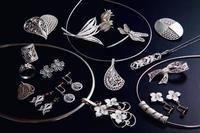

Total:131items
- Pottery & Porcelain (18)
- Lacquerware (4)
- Glasswork (2)
- Wood & Bamboo Work (19)
- Leather Work (1)
- Papermaking (13)
- Textile (20)
- Dyeing products (5)
- Masonry (1)
- Metal Work (11)
- Satsuma Suzuki: Satsuma Tinware
- Tosa Uchihamono: Tosa Blade
- Kaga Zougan: Kaga Inlay
- Akita Ginsen Zaiku: Akita Filigree
- Token: Japanese Sword
- Banshu-gama : Banshu Sickle
- Echigo-Sanjo Uchi Hamono: Echigo-Sanjo Blade
- Osaka Naniwa Suzuki: Pewter/Tin Ware
- Nakaniida-Uchihamono: Nakaniida Traditional Blade
- Higo-Tsuba
- Nokaji Hamono: Nokaji Blades
- Stationery (4)
- Livingware (3)
- Accessory (4)
- Toys & Entertainment (14)
- Interior (2)
- Other crafts (10)

 |
Main Production Site:Akita |
 《Characteristics》
《Characteristics》In "Akita Ginsen Zaiku", 0.1-0.3mm thin "Ginsen (silver wires)" made from pure silver are processed into various patterns with traditional techniques. Brilliance of silver brings grace and the delicate and elaborate patterns create the texture of the art works.
Ginsen zaiku (filigree), made by twisting thin pure silver wires only with fingertips, were initially used for hair accessories, kanzashi (Japanese hair sticks) for wedding and others by women of the warrior caste. From the middle of Showa period (20c), broaches, earrings, pendants, forehead ornaments and others have mainly been produced. The elaborate and delicate handicrafts have been highly evaluated not only at home but abroad.
Akita Ginsen Zaiku makes smooth curves and creates beautiful designs such as flowers and butterflies. In the handicraft, we can feel the warmth of Akita which comes from traditional artisan techniques.
[Traditional Craft (Designated by Akita prefecture)]
Information provided by: Akita City Craft Promotion Council
Translation by: Shione Furuta, reviewed by Marie Mine

| Materials | Silver |
|---|---|
| Crafting Processes | [1] Making Hirato
Roll up a silver wire skillfully with tweezers and fingertips to make a Hirato (a spiral part.) [2] Setting Hirato Make a frame of slightly thicker silver wires and set a Hirato into it. [3] Assembling Weld each processed part together using gin-ro (brass added silver) and shape it sterically into flowers or animals. [4] Rinsing Rinse the assembled parts with chemicals. [5] Finishing (Polishing) Polish the work repeatedly with a tool called kanabo (a metal rod.) This process makes the flexible silver wires firm to shine brightly. |
| History | Filigree in Japan is said to have its origin in Tenbun era (1532-1555) when it was introduced to Hirado, Nagasaki (Southern Japan) by Dutch.
It is alleged that techniques of filigree were brought to Akita because Edo Yashiki (a house where a daimyo lives during his stay in Edo for Sankin-kotai or alternate attendance) of Akita Domain and Hirado Domain were so close that they had cultural exchanges. After that, a silver mine was discovered in current Ogachi county of Yuzawa city (Akita Prefecture) in 1606 and it has provided abundant materials for filigree manufacturing. Silver filigree has been passed down until today through the production of weapons and accessories under the protection and the encouragement by the successive domain lords. Nowadays, accessories such as brooches, earrings, pendants and hair accessories are mainly produced with traditional techniques. |
◆Exhibition / Showcase
Akita City Craft Promotion Council
(in Tourism and Products Division, Commerce Department, Akita City)
Address: Sannou 1-1-1, Akita city
Telephone: +81- (0)18-866-2112 FAX: +81-(0)18-866-2425
(Japanese only)
Assistance needed? For inquiries in English:
JTCO Contact Form
Your inquiries will be forwarded by JTCO in Japanese to the organization you wish to contact.
Please specify the name of the craft/art you wish to inquire about.



